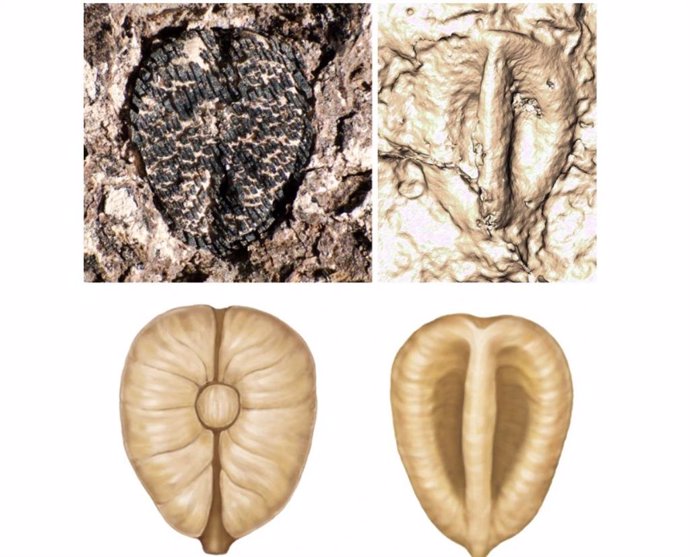Lithouva: the oldest fossil grape in the Western Hemisphere, about 60 million years old, from Colombia. – FABIANY HERRERA/POLLYANNA VON KNORRING.
1 Jul. () –
The end of the dinosaurs 66 million years ago led to the expansion of plants such as vines, according to scientists Fossil grapes from 60 to 19 million years old recovered in Colombia, Panama and Peru.
One of the species included in the findings represents the oldest known example of plants from the grape family in the Western Hemisphere, according to the research, published in Nature Plants.
“These are the oldest grapes that have been found in this part of the world, and they are a few million years younger than the oldest grapes that have been found on the other side of the planet,” he says. it’s a statement Fabiany Herrera, associate curator of paleobotany at the Field Museum’s Negaunee Integrative Research Center in Chicago and lead author of the paper. “This discovery is important because it shows that after the extinction of the dinosaurs, grapes really began to spread throughout the world.”
It is rare for soft tissues like fruits to be preserved as fossils, so scientists’ understanding of ancient fruits often comes from seeds, which are more likely to fossilize. The oldest known grape seed fossils were found in India and are 66 million years old.
It’s no coincidence that grapes appeared in the fossil record 66 million years ago, around the time a massive asteroid hit Earth, triggering a mass extinction that altered the course of life on the planet. “We always think about animals, dinosaurs, because they were the most affected, but the extinction event also had a huge impact on plants,” Herrera says. “The forest was restored, in a way that changed the composition of the plants.”
Herrera and his colleagues hypothesize that The disappearance of the dinosaurs may have helped alter the forests. “Large animals, like dinosaurs, are known to alter their surrounding ecosystems. “We thought that if there were large dinosaurs roaming the forest, they were probably knocking down trees, effectively keeping the forests more open than they are today,” says Monica Carvalho, co-author of the paper and an adjunct curator at the University of Michigan Museum of Paleontology. But without large dinosaurs to prune them back, some tropical forests, including those in South America, became more crowded, with layers of trees forming an understory and a canopy.
These new, dense forests provided an opportunity. “In the fossil record, we started seeing more plants that use vines to climb trees, like grapes, around this time,” Herrera says. The diversification of birds and mammals in the years after the mass extinction may also have helped grapes by spreading their seeds.
In 2013, Herrera’s PhD advisor and lead author of the new paper, Steven Manchester, published a paper describing the oldest known grape seed fossil, from India. Although fossil grapes had never been found in South America, Herrera suspected they might be there, too.
“Grapes have an extensive fossil record that begins about 50 million years ago, so I wanted to discover one in South America, but it was like looking for a needle in a haystack,” Herrera says. “I’ve been searching for the oldest grape in the Western Hemisphere since I was a college student.”
But in 2022, Herrera and co-author Monica Carvalho were conducting fieldwork in the Colombian Andes when they identified a grape fossil in a 60-million-year-old rock, making it not only the first South American grape fossil, but also one of the oldest grape fossils in the world.
The fossil seed is tiny, but Herrera and Carvalho were able to identify it based on its particular shape, size and other morphological features. Back in the lab, they performed CT scans that showed its internal structure, confirming its identity.
The team named the fossil Lithouva susmanii, “Susman’s stone grape,” after Arthur T. Susman, a proponent of South American paleobotany at the Field Museum. “This new species is also important because it is a species of grape that is thought to be a very rare species.” supports the South American origin of the group in which the common vine Vitis evolved.“says co-author Gregory Stull of the National Museum of Natural History.
The team conducted further fieldwork in South and Central America, and in the Nature Plants paper, Herrera and his co-authors ultimately described nine new fossil grape species from Colombia, Panama, and Peru, spanning from 60 to 19 million years ago. These fossilized seeds not only tell the story of the spread of grapes across the Western Hemisphere, but also of the many extinctions and dispersals the grape family has experienced. The fossils are only distant relatives of the native Western Hemisphere grapes, and a few, such as the two Leea species, They are only found in the Eastern Hemisphere today.
















Add Comment